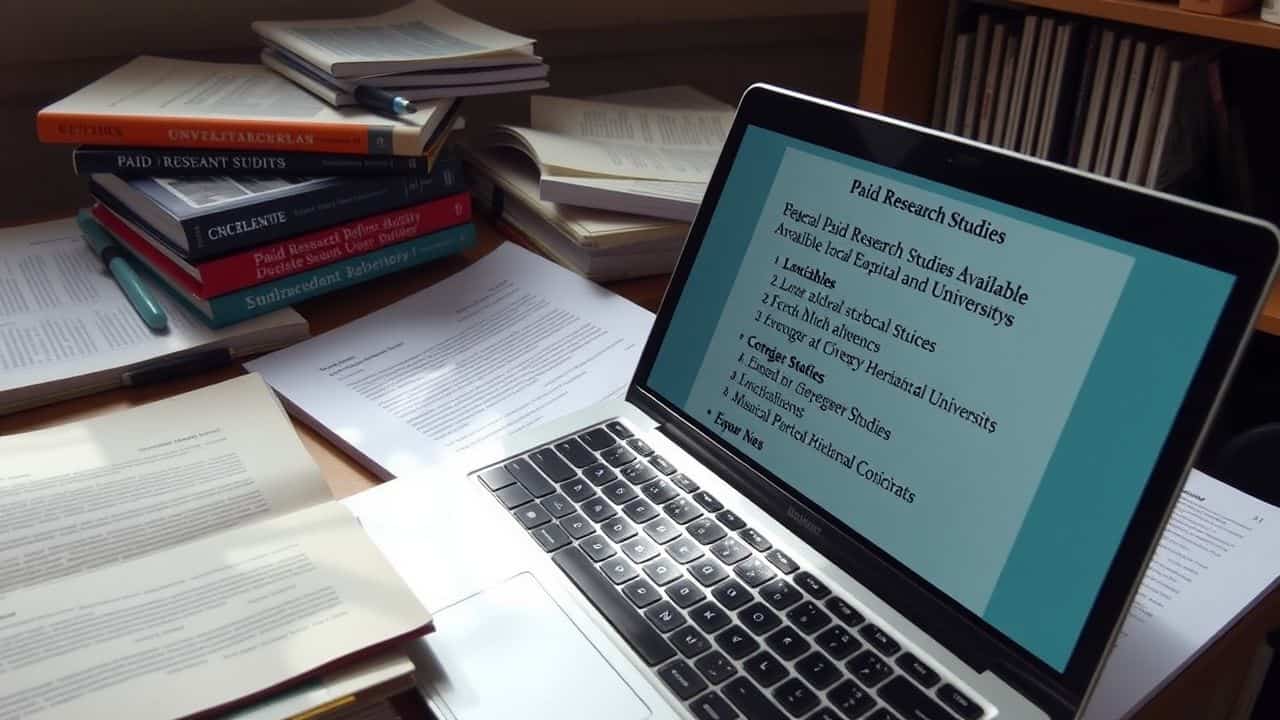Medical school costs a fortune, and finding ways to make money during your studies can feel impossible. The average medical student graduates with over $200,000 in student loan debt.
I’ll show you how to make money as a medical student through seven side hustles that fit into your busy schedule. These proven money-making methods have helped countless med students earn extra cash while building valuable skills.
Key Takeaways
Medical students can earn $100+ per hour through MCAT tutoring and pre-med course teaching, while EMT work pays $15-25 hourly with flexible shifts that fit around classes.
Research assistant roles at academic centers offer $15-25 per hour, while clinical trials can provide up to $3,000 yearly for study participants who help test new treatments and medications.
Medical content writing pays $50-100 per hour through platforms like Upwork and Fiverr, while starting a medical education YouTube channel can generate $500-800 monthly from sponsorships.
Plasma donation centers pay $20-50 per visit (twice-weekly), and medical research trials offer $100-500 per visit, with some vaccine trials paying up to $2,000 for complete participation.
The average medical student graduates with $200,000 in debt, making these side hustles crucial for managing expenses while gaining valuable healthcare experience and building professional networks.
Table of Contents
Tutoring Opportunities for Medical Students

Your medical knowledge can earn you extra cash through tutoring. As a med student, you can help pre-med students ace their MCAT or guide first-year students through tough anatomy classes.
Teaching Pre-Med or Medical School Courses

Teaching pre-med courses offers a fantastic way to earn money while building your teaching skills. Many medical students earn up to $100 per hour helping others grasp tough concepts in biology, chemistry, and MCAT prep.
The best part? You’ll reinforce your own medical knowledge while getting paid.
Medical schools often hire current students to lead study groups or teach lab sections. This side gig fits perfectly into a busy schedule since classes happen right on campus. Plus, teaching experience looks great on residency applications.
Medical students face unique financial challenges, and managing these effectively before focusing on earning money during their studies is crucial. Addressing high-interest rates on medical school loans early can significantly reduce long-term financial burdens. Options like refinancing medical student loans, choosing income-driven repayment plans, or making interest-only payments during school can help manage debt more efficiently.
By taking proactive steps, students can create a stable financial foundation, allowing them to prioritize their education and future career goals without unnecessary stress.
Providing MCAT Preparation Services
 MCAT prep services offer a golden opportunity to earn serious money as a medical student. Many pre-med students struggle with this tough exam and gladly pay top dollar for expert help.
MCAT prep services offer a golden opportunity to earn serious money as a medical student. Many pre-med students struggle with this tough exam and gladly pay top dollar for expert help.
I’ve seen fellow med students charge $100+ per hour for one-on-one MCAT tutoring sessions. The best part? You can set your own schedule and work from home through online platforms.
Your fresh experience with the MCAT makes you a perfect fit to guide others through this challenge. You can teach test strategies, explain tricky science concepts, or review practice questions.
Many tutoring companies will match you with students, though they take a cut of your earnings. Still, the steady stream of clients makes up for the lower pay rate. Next up, let’s explore how working as an EMT can boost both your income and medical skills.
Healthcare Roles for Medical Students

Healthcare jobs offer medical students a perfect blend of income and hands-on experience. You’ll gain real-world skills by getting help from Weatherby Healthcare or other providers, while earning money through part-time roles in hospitals, clinics, or medical offices.
Working as an Emergency Medical Technician (EMT)

EMT work puts you right in the action of emergency medicine. As a medical student, you’ll gain hands-on experience with real patients while earning $15-25 per hour. Most EMT programs let you pick flexible shifts that fit around your classes.
You’ll learn vital skills like quick thinking and staying calm under pressure.
EMTs are the first line of medical care – it’s where medicine meets real life. – Dr. Sarah Chen, Emergency Medicine Director
Many hospitals and ambulance services need EMTs for night and weekend shifts. The job teaches you to handle everything from basic life support to trauma care. Your EMT certification takes about 3-6 months to complete, and many programs offer evening classes.
The best part? The skills you learn as an EMT will make you a better doctor later.
Becoming a Phlebotomist

Phlebotomy offers a perfect side gig for medical students who need cash and hands-on experience. Teaching hospitals often hire part-time phlebotomists, letting you earn money while building valuable skills.
Mobile phlebotomy jobs give you extra freedom to pick your hours, with most work happening on evenings and weekends. This setup fits nicely around your busy class schedule.
Many mobile companies pay well for blood draws at homes or offices. You’ll need to complete a short certification course first, but the investment pays off fast. The best part? Your phlebotomy experience looks great on your medical resume.
Plus, you’ll get better at finding veins and talking to patients – skills you’ll use throughout your medical career.
Taking on a Medical Scribe Role

Medical scribes help doctors handle their electronic medical records (EMR). You’ll work side-by-side with physicians to document patient visits, update charts, and track lab results.
This role pays between $12-$16 per hour and offers amazing hands-on experience in patient care. The catch? You’ll need to match your schedule to your assigned doctor’s shifts, which means less control over your work hours.
Many medical students start as scribes to gain real-world healthcare experience before their medical internship.
The job teaches you medical terminology, common diseases, and how doctors think through cases. Plus, you’ll build strong relationships with healthcare teams. Next up, let’s explore how research opportunities can boost your income while building your medical career.
Research Opportunities in Medicine

Research labs pay good money for smart medical students who can help with studies. You’ll gain hands-on experience while earning cash as a research assistant or study participant in clinical trials.
Assisting as a Medical Research Assistant

Academic centers offer paid roles as medical assistant positions in their research labs. You’ll help doctors run clinical trials, collect data, and handle lab samples.
The flexible hours fit perfectly with med school schedules, plus you’ll gain hands-on experience in healthcare systems. Many positions let you work 10–20 hours per week around your classes.
Research assistants are the backbone of medical discovery, bridging the gap between theory and breakthrough. – Dr. Sarah Chen, Harvard Medical School
Your tasks might include organizing patient records, scheduling study participants, and helping with basic lab work. The pay ranges from $15-25 per hour at most institutions. This role opens doors to future specialties and builds strong connections with faculty members.
Let’s explore another exciting option – joining paid clinical trials as a participant.
Participating in Clinical Trials or Research Studies
Clinical trials offer a solid way to earn money while helping advance medical research. Many medical schools partner with research centers that pay volunteers up to $3,000 per year for joining their studies.
You’ll get paid to test new treatments, medications, or medical devices under expert supervision.
Medical students make perfect guinea pigs for these trials because they understand the science behind them. The process starts with a health screening to check if you qualify. Once approved, you’ll need to follow specific rules and show up for scheduled visits.
Most studies let you pick time slots that fit your class schedule. Some trials even focus on women’s health issues, making them extra relevant for female participants.
Creative Ventures for Medical Students

Got a knack for explaining medical terms in plain English? Your medical knowledge can earn you money through blogs and social media channels. Medical writers make good money by creating content for health websites, insurance companies, and medical education platforms.
Freelance Writing or Editing Medical Content
Medical writing offers a perfect side gig for med students with strong writing skills. Many medical writers earn $50-$100 per hour on platforms like Upwork and Fiverr. I started my journey writing blog posts about health topics and editing research papers for busy doctors.
The work fits nicely between study sessions, and you can pick up projects based on your schedule.
Medical writing isn’t just about income – it sharpens your clinical knowledge while paying the bills. – Dr. Sarah Chen, Medical Editor
Your medical background gives you an edge over regular writers in this field. Healthcare companies need people who understand medical terms and concepts. Start small with blog posts or patient education materials.
Then move up to technical writing for insurance firms or editing journal articles. The best part? You’ll build a solid portfolio for future opportunities in medical communications.
Speaking of building skills, let’s explore how starting a medical education channel can boost your income….
Starting a Medical Education Blog or YouTube Channel
Creating health content online can put extra cash in your pocket during med school. A blog or YouTube channel about med school life brings in money through ads and brand deals. I started my channel last year by sharing study tips and day-in-the-life videos.
The key is to post new content each week, even during busy exam periods. My channel now earns $500-800 monthly from sponsorships with study apps and medical supply companies.
Your personal brand grows stronger with each post you share. Stick to topics you know well, like MCAT prep or clinical rotations. I focus on helping other women in medicine navigate their journey through honest stories and practical advice.
The best part? You can film or write content during study breaks and schedule posts ahead of time. This side gig fits perfectly into a busy student schedule while building your professional network.
Flexible Jobs Suitable for Medical Students

Medical students can grab quick cash through jobs that fit their wild schedules. You’ll find plenty of night and weekend work options that won’t mess with your study time or clinical rotations.
Driving for Ride-Share and Food Delivery Services
Ride-share and food delivery gigs offer perfect flexibility for busy med school life. Apps like Uber, Lyft, and DoorDash let you earn money on your own schedule. I started driving for UberEats between study breaks last year, and it’s been a game-changer for my budget.
You can pick up orders during lunch breaks or after evening classes. The best part? No boss breathing down your neck!
My car became my part-time office, turning dead time into dollars while I pursued my medical dreams.
These platforms pay weekly, which helps with regular expenses like groceries and coffee runs. Most services need just a valid driver’s license, insurance, and a reliable car to get started.
Bonus tip: Many drivers work for multiple apps at once to maximize earnings. GrubHub and Postmates often have peak hours during dinner rushes, making them ideal for evening shifts after labs.
The work keeps you moving and gives your brain a break from heavy medical textbooks.
Babysitting, Bartending, or Waiting Tables
Babysitting offers a perfect study-friendly side gig for medical students. Most parents need sitters during evening hours, which lets you hit the books after the kids go to bed. You’ll earn money while getting valuable study time.
Plus, many families offer steady weekly schedules that fit neatly around medical school classes.
Restaurant work packs a double punch for extra income. The food service industry needs more workers now than ever since the pandemic. Bartending and waiting tables bring in quick cash through tips, and the night shifts work well with daytime classes.
Many medical students pick up weekend shifts at local spots to boost their income. The flexible scheduling helps you balance work with your medical studies. Next up, let’s explore how medical surveys and studies can pad your wallet.
Surveys and Studies for Medical Student Participation

Medical students can earn extra cash by joining paid research studies at local hospitals and universities. These studies often pay well for your time, plus you’ll gain first-hand experience in clinical research while helping advance medical science.
Joining Medical-Related Surveys or Focus Groups
Paid surveys offer a flexible way to earn extra cash during med school breaks. Smart ladies can pocket up to $3,000 yearly just by sharing their medical opinions and experiences.
- Online medical survey platforms need female voices for research studies. Sign up with trusted sites like M3 Global Research or ZoomRx to receive survey invites straight to your inbox.
- Focus groups pay better than regular surveys, often ranging from $100-$500 per session. These groups discuss topics like health insurance policies and new medical treatments.
- Clinical trial participation brings in serious money – up to $15,000 for longer studies. Your medical background makes you an ideal candidate for these research opportunities.
- Survey companies love getting input from future healthcare pros. Your pre-med or nursing knowledge adds extra value to pharmaceutical and medical device research.
- Quick 15-minute surveys typically pay $5-25 each. Tackle these between classes or during study breaks for steady pocket money.
- Local hospitals and research centers run paid focus groups regularly. Build connections with research departments to get first dibs on high-paying studies.
- Many surveys offer Amazon gift cards or PayPal cash. Pick payment options that work best for your lifestyle and spending habits.
- Set up email alerts for surveys matching your expertise. Topics range from mental health treatments to family medicine practices.
- Keep track of your survey earnings for tax purposes. Most companies will send 1099 forms if you earn over $600 yearly.
Donating Plasma or Participating in Compensated Studies
Medical students can earn extra cash through plasma donation and research studies. These options offer flexible schedules and good pay without interfering with your studies.
- Plasma donation centers welcome students twice per week, paying $20-$50 per visit. Your body makes new plasma quickly, so regular donations won’t affect your energy levels for studying. Many centers offer sign-up bonuses and referral rewards too.
- Medical research trials at teaching hospitals need healthy volunteers. Studies often pay $100-$500 per visit, depending on time commitment and procedures involved. Most trials work around your class schedule.
- Focus groups for healthcare products and services pay $50-$200 for a few hours of feedback. Medical students bring valuable insights that companies really want.
- Sleep studies run overnight and pay $100-300 per study. You can catch up on rest while earning money during off-hours from classes.
- Vaccine trials offer payments of $500-$2000 for completing multiple visits. Your medical background helps you grasp the risks and benefits clearly.
- Psychology studies at university labs pay $15-30 per hour. These quick studies fit easily between classes or during lunch breaks.
- Blood type studies need rare blood donors and pay premium rates of $200-500 per donation. Your medical knowledge helps you understand the screening process.
- Drug trials by research companies pay $1000+ for longer studies. They value medical students who can track and report symptoms accurately.
People Also Ask
What are the top ways medical students can earn extra money during school?
Medical students can work as research subjects, try medical coding, or become medical transcriptionists. Some even explore medical underwriting or work as personal trainers. These side jobs fit well with busy study schedules.
How much can medical students earn from biological donations?
Egg donation can pay up to $10,000 per cycle, while sperm donation offers regular income. Both options help build retirement savings or pay off student loans through various repayment plans.
Can medical students work in healthcare roles before residency?
Yes! Some medical students work part-time helping nurses or taking online courses in medical transcription. These roles offer valuable experience before starting medical residency in specialties like internal medicine or family physicians.
What financial options are available for medical students beyond financial aid?
Besides traditional credit options, medical students can work with registered investment advisors to plan their finances. Many also build professional networks on LinkedIn to find paid opportunities during medical school.
How do medical residents balance work and study?
Medical residents often juggle their salary with side gigs. The key is picking flexible jobs that don’t interfere with caring for policyholders or patients. Smart time management helps balance earning and learning.
References
https://passiveincomemd.com/blog/entrepreneurship/my-med-school-side-hustles/ (2018-07-10)
https://morethanmedics.org/top-5-side-hustles-for-medics/
https://www.thefinitygroup.com/blog/how-to-make-money-while-in-medical-school/
https://www.shemmassianconsulting.com/blog/medical-student-side-gigs (2021-12-17)
https://www.ems1.com/family-home/articles/7-perfect-side-jobs-for-an-emt-7v2eqMAiV3fj2NkN/
https://ipsnews.net/business/2024/06/01/19-best-side-hustles-for-medical-students-to-make-money/
https://www.careervillage.org/questions/715931/how-can-i-make-money-while-being-in-medical-school
https://lifehacker.com/you-can-make-real-money-participating-in-clinical-trial-1850830014 (2023-09-12)
https://www.savethestudent.org/make-money/get-paid-for-drug-trials.html
https://thefreelancersyear.com/blog/how-to-become-a-medical-writer/
https://www.makingsenseofcents.com/2014/12/lyft-and-uber-driver-side-hustle-idea.html
https://forum.whitecoatinvestor.com/general-welcome/453506-side-hustles-as-a-medical-student (2024-07-11)
https://www.sermo.com/resources/side-hustle-for-doctors/ (2023-10-23)
https://believeinabudget.com/side-hustle-true-story-i-was-in-a-medical-research-study/ (2024-02-20)
